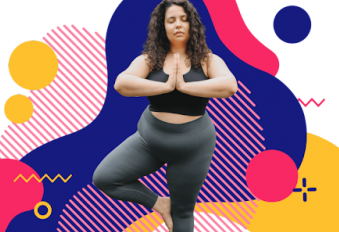Exercise and movement are important for our bodies. According to the Centers for Disease Control, being physically active helps in a variety of ways. Physically, it reduces the risks of diseases and improves muscle and bone strength. Not to mention the tremendous benefits that we receive from movement as it relates to our mental health.
Exercise releases endorphins in our brains that make us feel happy. It is also proven to have positive benefits for overall brain health.
Yet, when healing from an eating disorder, exercise is encouraged to be put on pause or very minimal as it could be a trigger for relapse. It can be confusing as exercise is important to health but it oftentimes becomes heavily associated with a tool for weight loss.
For someone recovering from disordered eating, it is imperative to look at how exercise has impacted the disorder and the way that you view your body.
Consider some of the following questions:
- How does exercise make you feel?

- In what ways might exercise be used as a form of weight loss or control?
- What happens on days when you are not able to exercise?
- Is the amount that you exercise related to the way that you see your body?
Unfortunately, the mentality around exercise is one of the hardest to change, and sometimes not engaging is the only way to avoid the harmful habits that contribute to the eating disorder.
Given that movement is beneficial for overall health and well-being, how does one create a new relationship to movement while in recovery from disordered eating?
How to improve your relationship with exercise/movement:
Pause & get curious.
Think about movement for the sake of moving. Consider what your body really needs at the moment. Listen to your body.
As you engage in exercise, stay attuned to your body’s response and give yourself permission to intuitively follow what your body really needs. No rules, and no expectations. Reflect on how your body feels right after or a few hours later, did it help you feel more energized, relaxed, or sore?
Move when you want to move.
As you become more familiar with the subtle feelings in your body, you’ll know when you have the energy for movement. Maybe it is a certain time of day or day of the week. Start gently. Remember that movement comes in many forms from walking, dancing, or stretching.
Move for the feeling of joy.
Exercise produces endorphins in the brain. Endorphins make us feel happy. After exercising or movement, we should be experiencing joy or pleasure.
One indicator that the amount or type is not right is the lack of a happy or pleasurable feeling after exercising. If you’re not regularly experiencing this, then it is time to adjust!
Healing your relationship with exercise while also rebuilding your relationship with food and your body is challenging. Movement is a key part of living a healthy life. Learning to find joy in movement again and connecting to your body’s intuitive need for movement can foster a stronger recovery journey.
If you would like to learn more about improving your relationship with exercise, we offer mindful movement groups and individual coaching.
The first step is to schedule a complimentary 15-minute call.
Written by Leah Ehinger, MSW, ASW, RYT


